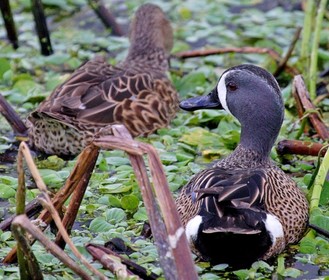 Blue-winged Teal at Green Cay Wetlands.
Green Cay Wetland is a 100-acre nature preserve nestled among the neighborhoods of Boynton Beach. This farmland turned wetland provides valuable habitat for more than 250 bird species and is an excellent example of habitat restoration by Palm Beach County.
Start your adventure in the impressive exhibit room at the Green Cay Nature Center, where you can learn about wetlands before venturing into one. The 1.5-mile elevated boardwalk lets you traverse cabbage palm hammock, cypress swamp, wetland hammock and tropical hardwood hammock without even getting your shoes muddy. The boardwalk is friendly to strollers and wheelchairs. Get out over the water and explore! Make sure you bring your camera as the birds are everywhere, from wintering Painted Buntings at the nature center to migratory songbirds in the forest, and wetland favorites like Roseate Spoonbills, Glossy Ibis, Purple Gallinule, Blue-winged Teal, Green-winged Teal and more. In the winter Green Cay Wetlands is one of the best places to see American Bitterns in all of Florida.
This site is popular not just due to its impressive bird list, but also for the easy access it gives nearby communities to nature. However, visiting is worth the trip even if you don’t live in the area. Wakodahatchee Wetlands, another impressive birding destination, is just a five-minute drive away. The combination of these amazing sites makes it well worth a day trip for an avid birder, or for anyone who enjoys spending time in nature in an accessible and family friendly setting.
Take a virtual tour of Green Cay Wetlands and Nature Center.
Learn more on our website.
 Blue-headed Vireo with Stink Bug by Travis Blunden.
Insects may be hated as pests or praised as pollinators. However, insects have another vital role: they’re bird food (and food for other animals). Birds eat around 400–500 million tons of insects per year, and insects are an especially important food source for breeding birds in temperate climates. The fresh green leaves of spring support huge numbers of insects, and birds take full advantage of this feast to raise their young. This type of food boom doesn’t happen in the tropics and can allow birds that migrate to colder climates to raise more offspring than those that don’t. For many birds, successful parenthood means feeding their chicks as many insects as they can find.
Unfortunately for birds and bird-lovers, the number of insects is declining. One reason for this is habitat loss. Human settlement and farming remove the native plant communities that insects need, often allowing them to be replaced by non-native invasive plants that support little to no local insect life, and little to no bird life by extension. America has lost 3 billion breeding birds in the past fifty years. While the causes of this decline are varied and complex, we can do our part to help the birds in our communities and gardens thrive by encouraging insects (especially caterpillars) in our gardens, with the added benefit of encouraging butterflies as well!
Each type of caterpillar tends to eat only certain types of plant. This is because plants protect themselves by tasting unpleasant or even being toxic. However, certain caterpillars aren’t bothered by the defenses of certain plants. Instead, they use them as their main food source. A classic example is the Monarch butterfly. Adults can feed on a wide range of flowers, but Monarch caterpillars can only eat milkweed. They don’t get sick from milkweed toxin and even benefit from it since it makes them toxic to predators. Luckily, there are some plants that can host a wide range of insects and make great additions to your garden. Native Plant Finder is a wonderful tool provided by the National Wildlife Federation to find out what native plants in your county attract the most butterflies and moths.
To learn more about attracting birds, butterflies and other wildlife to your yard, you can order a copy of Planting a Refuge for Wildlife from the Fish and Wildlife Foundation of Florida.
|